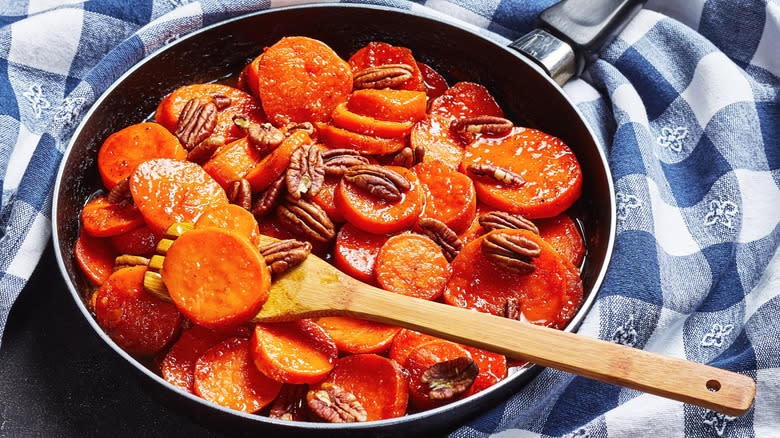Why It Always Pays To Prep Candied Yam Glaze Beforehand

The casserole-style dish known as candied yams is common on countless holiday tables, but make no mistake, this is by no means just a once-a-year kind of side. If you have the secret to the most perfectly prepared version of this classic, you'll want to make it a far more frequent staple that graces your table on a regular basis.
Surprisingly, although the rich, complex flavor created by the caramelized sugars and the inherent sweetness of the roasted roots are almost infallibly delicious, there is a way to ensure an even more satisfying iteration. This game-changing twist doesn't require additional ingredients; it's just about taking the process in steps and building layers that will really pay off later.
Instead of simply sprinkling a combination of sugar, water, and vanilla over the yams and tossing the whole thing in the oven, in this version, you prepare the glaze on the stovetop separately beforehand. From there, tossing this new flavor-packed ingredient with your par-cooked yams allows you to create a fully coated and totally integrated dish where every bite is packed with just as much flavor as the first.
Read more: 8 Baking Sheet Mistakes You Want To Avoid
Why It Works

The standard recipes often call for the yams (the tuber often mistaken for sweet potatoes and frequently imported from Nigeria) to be partially cooked by boiling them on the stovetop. Then, the sugar, vanilla, and water are typically combined in a bowl and poured over the top of the yams before they're popped into the oven. You must rely on the sugar melting and combining smoothly in the oven, and depend on gravity for distributing the glaze over the yam chunks below, which often results in uneven flavoring.
In this alternate version, you begin the same way — with boiled par-cooked roots — but once you set those in your baking dish, you take the extra step that makes all the difference: Cooking your sugar, vanilla, and water into a glaze before pouring it over the yams. This ensures that your sugars fully melt and your flavors meld, making a smooth and syrupy liquid that can then be tossed with the yams rather than simply poured over top of them. This way, not only can you easily avoid crunchy clumps of brown sugar that fail to melt and distribute during the baking process, but you can fully coat each yam piece, getting that sweet and sticky goodness into every crevice rather than only the top layer.
While it may take a few extra minutes -- and dishes -- to make your glaze beforehand instead of mixing and cooking all of the ingredients at once, that bit of advance effort is well worth it.
Other Ways To Amp Up Your Yams

The combination of brown sugar, water, and vanilla is pretty flawless, but your candied yams don't have to be limited to this profile. Classic recipes for candied yams (or its sister dish, candied sweet potato casserole), call for spices like cinnamon and nutmeg, but the flavors of brown sugar and these naturally sweet tubers go so well with so many others, that you can use this as an opportunity to get super creative.
Change up your spices and include cloves or allspice. Even add a little cayenne or paprika for a kick. Different types of brown sugar will yield a range of flavors as well, with something like Demerara bringing a distinctly molasses-like character to the mix. You can put on a tropical spin by adding pineapple, raisins, and coconut to your casserole. Add texture with toasted nuts like almonds, pecans, or hazelnuts. Herbs like sage or rosemary are right at home with this dish, too. You can even test out some alternate extracts like almond or orange, and grate some fresh citrus zest into your glaze on the stovetop to give the whole thing a little zip. With your evenly glazed and perfectly cooked yams, you can find new ways to make this dish a staple any day of the week, any time of the year.
Read the original article on Daily Meal.


